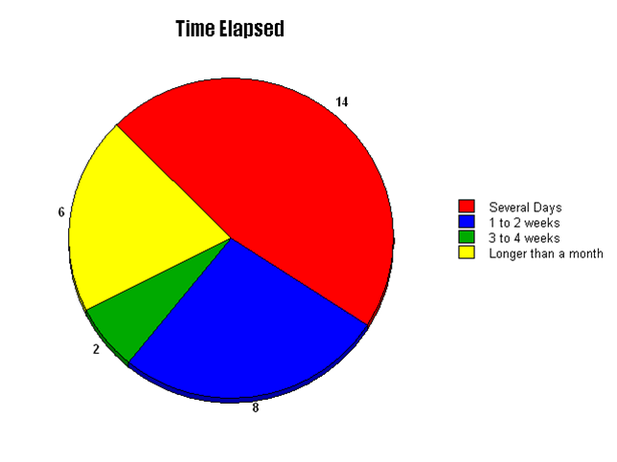RECOVERY
Surveys
Our group collected two different surveys; Survey A regards physical recovery from broken bones, while Survey B regards recovery from a traumatic death. Survey A was conducted by directly asking a wide variety of people face-to-face, while Survey B was conducted online via Zoomerang.
Survey A
In this survey, we asked fifty people of all different ages about their recovery process after breaking various bones.
1. What bone in your body did you break?
2. How old were you when you broke this bone?
3. How many weeks did you have a cast?
4. Did you require surgery?
After analyzing our results, we noticed that close to 75% of the breaks were wrists and ankles.These two parts are frequently used and are two of the most common breaks. Most of the people we interviewed broke their bones when they were younger. This is because children are more activie in sports tha adults. As you grow older, the recovery process from a broken bone gets longer and longer. Children and teenagers can take four to six weeks to fully heal a broken wrist while adults and elders can take up to three months to fully heal. This is because more bone fragments are produced as we are growing. Surgery is most commonly needed in adults over the ago of twenty five.
1. What bone in your body did you break?
2. How old were you when you broke this bone?
3. How many weeks did you have a cast?
4. Did you require surgery?
After analyzing our results, we noticed that close to 75% of the breaks were wrists and ankles.These two parts are frequently used and are two of the most common breaks. Most of the people we interviewed broke their bones when they were younger. This is because children are more activie in sports tha adults. As you grow older, the recovery process from a broken bone gets longer and longer. Children and teenagers can take four to six weeks to fully heal a broken wrist while adults and elders can take up to three months to fully heal. This is because more bone fragments are produced as we are growing. Surgery is most commonly needed in adults over the ago of twenty five.
Survey B
1. How many of your close family members and/or friends have passed away? Close family members include siblings, parents, grandparents, cousins, aunts and uncles.
2. At what age did you experience your most traumatic loss thus far in your life?
3. After experiencing your most traumatic loss, about how much time elapsed before you were able to resume normal daily activities?
4. If you were to lose an important person in your life, how much would it affect you?
5. What would you do to recover from a difficult death? (Check all that apply)
6. What difficulties have you gone through to recover from traumatic losses?
2. At what age did you experience your most traumatic loss thus far in your life?
3. After experiencing your most traumatic loss, about how much time elapsed before you were able to resume normal daily activities?
4. If you were to lose an important person in your life, how much would it affect you?
5. What would you do to recover from a difficult death? (Check all that apply)
6. What difficulties have you gone through to recover from traumatic losses?
